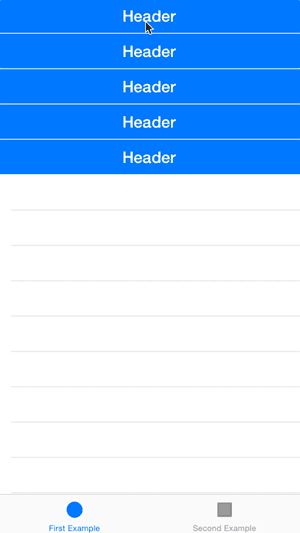Expandable tableView in iphone
If this helps: [Access uitableview's expandable and collapsable sections] https://github.com/OliverLetterer/UIExpandableTableView
I have a little bit of a different approach to expandable table views - one that aligns with how these kinds of table views are generally built.
There are headers and there are cells. Headers should be tappable, and then cells underneath the headers would show or hide. This can be achieved by adding a gesture recognizer to the header, and when tapped, you just remove all of the cells underneath that header (the section), and viceversa (add cells). Of course, you have to maintain state of which headers are "open" and which headers are "closed."
This is nice for a couple of reasons:
- The job of headers and cells are separated which makes code cleaner.
- This method flows nicely with how table views are built (headers and cells) and, therefore, there isn't much magic - the code is simply removing or adding cells, and should be compatible with later versions of iOS.
I made a very simple library to achieve this. As long as your table view is set up with UITableView section headers and cells, all you have to do is subclass the tableview and the header. Try it :)
Link: https://github.com/fuzz-productions/FZAccordionTableView

Finally i get two very useful helping link below which describes exact what the requirement is here
Expanding/Collapsing TableView Sections
Collapsable Table View for iOS
Really, good articles for such kind of expanding/collapsing tableview sections
Use Following code for expandable Cell into UITableView
- (UITableViewCell *)tableView:(UITableView *)tableView cellForRowAtIndexPath:(NSIndexPath *)indexPath
{
static NSString *CellIdentifier = @"Cell";
UITableViewCell *cell = [tableView dequeueReusableCellWithIdentifier:CellIdentifier];
if (cell == nil) {
cell = [[[UITableViewCell alloc] initWithStyle:UITableViewCellStyleDefault reuseIdentifier:CellIdentifier] autorelease];
}
cell.textLabel.text=[[self.arForTable objectAtIndex:indexPath.row] valueForKey:@"name"];
[cell setIndentationLevel:[[[self.arForTable objectAtIndex:indexPath.row] valueForKey:@"level"] intValue]];
return cell;
}
code for expanding & collapsing rows – TableView DidSelectRow Method
- (void)tableView:(UITableView *)tableView didSelectRowAtIndexPath:(NSIndexPath *)indexPath
{
[tableView deselectRowAtIndexPath:indexPath animated:YES];
NSDictionary *d=[self.arForTable objectAtIndex:indexPath.row];
if([d valueForKey:@"Objects"]) {
NSArray *ar=[d valueForKey:@"Objects"];
BOOL isAlreadyInserted=NO;
for(NSDictionary *dInner in ar ){
NSInteger index=[self.arForTable indexOfObjectIdenticalTo:dInner];
isAlreadyInserted=(index>0 && index!=NSIntegerMax);
if(isAlreadyInserted) break;
}
if(isAlreadyInserted) {
[self miniMizeThisRows:ar];
} else {
NSUInteger count=indexPath.row+1;
NSMutableArray *arCells=[NSMutableArray array];
for(NSDictionary *dInner in ar ) {
[arCells addObject:[NSIndexPath indexPathForRow:count inSection:0]];
[self.arForTable insertObject:dInner atIndex:count++];
}
[tableView insertRowsAtIndexPaths:arCells withRowAnimation:UITableViewRowAnimationLeft];
}
}
}
A Method which will help to minimize & maximize/expand-collapse rows.
-(void)miniMizeThisRows:(NSArray*)ar{
for(NSDictionary *dInner in ar ) {
NSUInteger indexToRemove=[self.arForTable indexOfObjectIdenticalTo:dInner];
NSArray *arInner=[dInner valueForKey:@"Objects"];
if(arInner && [arInner count]>0){
[self miniMizeThisRows:arInner];
}
if([self.arForTable indexOfObjectIdenticalTo:dInner]!=NSNotFound) {
[self.arForTable removeObjectIdenticalTo:dInner];
[self.tableView deleteRowsAtIndexPaths:
[NSArray arrayWithObject:[NSIndexPath indexPathForRow:indexToRemove inSection:0]]
withRowAnimation:UITableViewRowAnimationRight];
}
}
}
You can download the source code from my tutorial site.